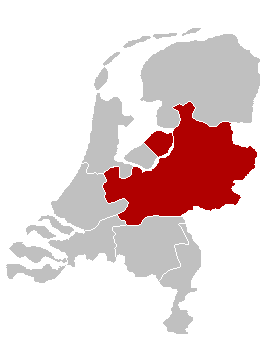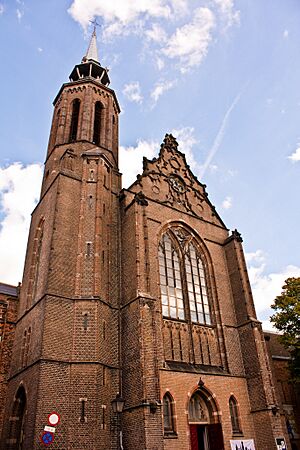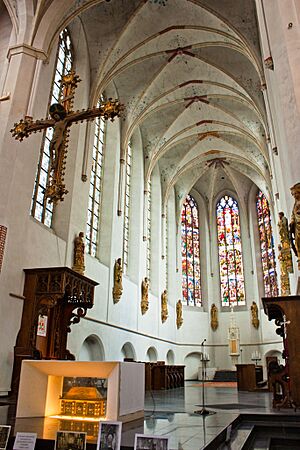Roman Catholic Archdiocese of Utrecht facts for kids
Quick facts for kids Roman Catholic Metropolitan Archdiocese of UtrechtArchidioecesis Metropolitae Ultraiectensis Latinorum Aartsbisdom Utrecht |
|
|---|---|

Coat of arms
|
|
| Location | |
| Country | Netherlands |
| Territory | Parts of the provinces Utrecht, Overijssel, Gelderland, and Flevoland |
| Coordinates | 52°05′15″N 5°07′27″E / 52.08750°N 5.12417°E |
| Statistics | |
| Area | 10,000 km2 (3,900 sq mi) |
| Population - Total - Catholics |
(as of 2020) |
| Information | |
| Denomination | Catholic |
| Sui iuris church | Latin Church |
| Rite | Roman Rite |
| Established | 695, Archbishopric from 12 May 1559 |
| Cathedral | Saint Catherine's Cathedral |
| Patron saint | Saint Willibrord |
| Current leadership | |
| Pope | Francis |
| Archbishop | Wim Eijk |
| Auxiliary Bishops | Theodorus Cornelis Maria Hoogenboom Herman Willebrordus Woorts |
| Emeritus Bishops | Johannes Antonius de Kok Auxiliary Bishop Emeritus (1982–2005) |
| Map | |
 The location of the Archdiocese of Utrecht in the Netherlands |
|
The Archdiocese of Utrecht is a very important part of the Catholic Church in the Netherlands. It is like a large church region led by a main bishop called an archbishop. The Archbishop of Utrecht is the leader for several other church regions, called dioceses, in the Netherlands.
These other dioceses that work with Utrecht are Breda, Groningen-Leeuwarden, Haarlem-Amsterdam, Roermond, Rotterdam, and 's-Hertogenbosch. The main church for the Archdiocese of Utrecht is Saint Catherine's Cathedral.
Contents
History of the Archdiocese
The story of the Archdiocese of Utrecht began a very long time ago. It was first started as a diocese in the year 695.
Early Days and Changes
During the Middle Ages, the bishops of Utrecht were not just church leaders. They were also powerful rulers of a territory called the Prince-Bishopric of Utrecht. This meant they had both religious and political power. However, the church's spiritual area, the Diocese of Utrecht, was much larger than the land they ruled.
In 1580, the diocese faced a big change. Because of the rise of Protestantism, the diocese was closed down. For a long time, the Catholic Church had to find different ways to serve its followers in the area.
Re-establishment in Modern Times
The modern Archdiocese of Utrecht was officially set up again in 1853. Since then, it has continued to serve the Catholic community in the Netherlands.
Archbishops of Utrecht Since 1853
Since the archdiocese was re-established in 1853, many archbishops have led the community. Here is a list of the archbishops who have served:
- Johannes Zwijsen (1853–1868)
- Andreas Ignatius Schaepman (1868–1882)
- Petrus Matthias Snickers (1883–1895)
- Henricus van de Wetering (1895–1929)
- Johannes Henricus Gerardus Jansen (1930–1936)
- Johannes de Jong (1936–1955) (He became a cardinal in 1946)
- Bernardus Johannes Alfrink (1955–1975) (He became a cardinal in 1960)
- Johannes Gerardus Maria Willebrands (1975–1983) (He became a cardinal in 1969)
- Adrianus Johannes Simonis (1983–2007) (He became a cardinal in 1985)
- Willem Jacobus Eijk (since 2007) (He became a cardinal in 2012)
More to Explore
- Roman Catholicism in the Netherlands
- Religion in the Netherlands



